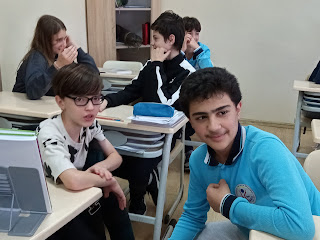Fulbright Update:
IRC event explores the question, Why does Moldova matter?
What's happening in Moldova, and why does Moldova matter? At the gracious invitation of
the International Relations Council of Kansas City (IRC), I endeavored to
answer these questions during a recent webinar.
I started with a map of Moldova, and discussed its
precarious situation, bordered on three sides by Ukraine, as well as by a
breakaway region, Transnistria, that menacingly hosts 1,500 Russian troops. So
far, I noted, those troops haven’t moved since the Ukraine war started, either
to attack Ukraine or Moldova. I also noted that Moldova is very polarized, with
a Romanian speaking majority that is generally pro-West and pro-EU, and a
minority speaking Russian who are anti-EU and pro-Russia. For example, a recent
poll showed that 21% of Moldovans say Russia was justified to invade Ukraine,
while 31% believe Russia “guarantees
peace” in Moldova (Seed/USAID, 2022).
We then discussed the Ukraine-Russia war’s many impacts
on Moldova, the first of which is energy. Moldova has been traditionally dependent on Russian gas, so when the Russians cut off Moldova's gas (for supporting Ukraine), it lead to blackouts and brownouts in 2022, and steep price increases (because the European energy they buy now is much more expensive) that made energy unaffordable for many Moldovans. According to UNDP, 60% of Moldovans live in 'energy poverty,' meaning they spend more than 10% of their income on energy bills.
The refugees generated by the war have also had a
substantial impact on Moldova. Moldova currently houses more refugees per
capita than any other country, according to the International Centre for
Migration Policy Development. With a population of 2.6 million, the country is
home to 119,000 refugees as of 3 October, 2023. Border crossings from Ukraine
since 24 February 2022 number 952,819, according to UNHCR.
I also mentioned how Russian disinformation is targeting
Moldova. In a comprehensive report called Blurring the Truth, the Konrad Adanauer Foundation says that Moldova is especially vulnerable to
disinformation because it is polarized and has many Russian language media
consumers. The themes of this disinformation are essentially anti-EU and
pro-Russia, characterizing the West at warmongers, and warning that embracing
the West means rejecting "traditional" pro-family values, and embracing pro-LGBTQ values.
In concluding, I summarized that Moldova is at a
crossroads. The country is on track for EU membership in 2030, if all the EU
requirements are met. Will Moldova continue on the path to a prosperous future,
or will it take an eastward turn instead, taking a road back into the Soviet
era and into the waiting arms of a Russia eager to manipulate and exploit it?
2.6 million Moldovan lives, as well as security and stability throughout
eastern Europe, are at stake. USAID has pumped $640 million in aid to Moldova
since 1992, so the U.S. has a financial stake here, too.
The Q and A session was lively and interesting. One
participant asked how Moldova can consider itself a democratic country, yet
still ban an opposition political party. My response was that this party,
called Sor after it’s pro-Russian founder, operated illegally, both by
accepting foreign contributions from Russia, and by illegally bribing voters
and election officials. Another question asked about Moldova’s potential for
tourism. I said that, once the Ukraine war ends, this potential is enormous.
The country is very pretty, the wine is great, the capital Chisinau is
cosmopolitan, and the rural areas perfect for cultural tourism that highlights
this region’s traditional charms. One questioner asked what I thought the
Russian troops in Transnistria would do, and my answer was, essentially,
nothing. In the big picture of the Ukraine war, 1,500 troops aren’t much, and
they better serve Russian interests by staying put and menacing Moldova.
I always love these IRC events because of the high level
of discourse, and thus look forward to my next invitation at the IRC.









